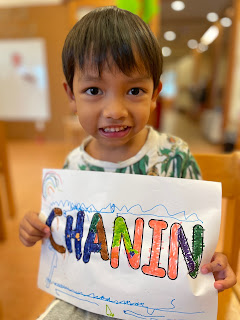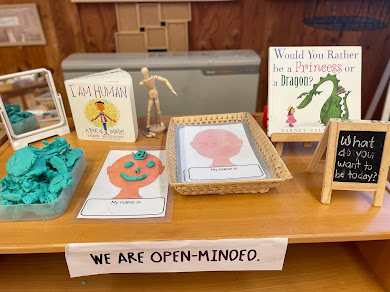3: Lessons from the Sandbox
"All I really need to know about how to live and what to do and how to be I learned in kindergarten."
-Robert Fulghum
What is your best memory of Kindergarten?
All of us have a memory or two of our first school experience. Some may be wonderful, some may not be as pleasant, but these experiences helped shape us into who we are now — even if we had them when we were just 5 years old.
When I was that age, an author named Robert Fulghum published an essay called
All I Really Need to Know I Learned in Kindergarten. In his essay, he talked about the wisdom that we gain while playing in the Kindergarten sandbox rather than in grad school, and how essential these lessons are in making the world a better place.
I found his essay to be a good reminder of what the children need to learn,
apart from the ones that we planned for in our curriculum.
This week, we made our first memory in Kinder 2 by learning lessons from the “sandbox” — ones that are anchored on the attributes that can empower us to become a better person for ourselves and for others.
THE ATTRIBUTES OF THE LEARNER PROFILE
1: On Being Caring
They reflected on their personal experiences and shared some beautiful insights on what it means to care.
We used these actions to recognize when we are caring in the classroom by putting our friends' names on the chart whenever we witness a kind act from them. Apart from this, we also record the other ways that our friends have been kind to us through their actions.
We can't wait for the list to grow this year!
2: On Being an Inquirer, Being a Thinker, and Being Knowledgeable
Children like to ask questions to make sense of the world. They are naturally curious so they ask, wonder, and explore -- and we value these in the Kindergarten classroom.
We read A Book of Questions to teach the children what questions are -- to make them realize that any question is okay, regardless of how simple (and sometimes silly) they think it is.
Then, we transformed the biggest window in our room into an I Wonder, I Think, I Know wall to highlight the children's curiosities, and to make feel that their questions are important. Apart from this, we want to build a culture of sharing bits and pieces of what we know and what we think we know, so that others can learn from us, too.
Just recently, I learned from one of the children that mosquitoes release their saliva before they bite you. Isn't it great to learn something new everyday? 😃
3: On Being a Risk-Taker
I have always loved making art as a child, but I remember getting disheartened every time I made a mistake. I discovered a book called the Beautiful Oops! by Barney Saltzberg that highlights the beauty of mistakes. It offers us the perspective that mistakes can be an opportunity to learn and to become better, which I find to be truly empowering.
After reading the book, I showed the children that I make mistakes, too. I tried to paint certain things but I just kept on getting it wrong. When I wanted to throw them away, the children all said, "No!" They said that they can make something with it. Each child got one of my "mistakes" and transformed it into their own work of art.
Mistakes can be beautiful too, don't you think so?
4: On Being Balanced
Sometimes, in being kind to others, we forget to be kind to ourselves. I wanted to teach the children the importance of their well-being and to recognize that their outlook in life matters.
One book recommendation for this attribute is Ish by Peter H. Reynolds. The story focuses on the journey of Ramon, a boy who loves to draw but was discouraged by his brother's remarks about his art. His little sister showed him that he doesn't need to make it perfect, and that his "ish" drawings are beautiful on their own. And so, his outlook changed and he became happy and content.
I reminded the children of the mantra that we practiced last week, "It's okay!"
It's okay to be different.
It's okay to make mistakes.
It's okay to learn.
It's okay to be ish.
It's okay to be you.
And with that, the children created their own ish-es just like Ramon. They understood that it's okay if it's not perfect, what matters is that they enjoy what they are doing.
5: On Being a Communicator
Stories open us to new worlds and take us on adventures without leaving the comfort of our home. I want the children to develop a love for books, so as early as now, I introduced a culture of reading in class. We try to read a book every day and created a quiet nook for reading independently.
Apart from this, I've also set up a loose parts table where the children can get materials to use for sharing their own story and creating adventures for others to enjoy.
6: On Being Principled
Use our classroom voice.
Kind hands.
Walk only in the classroom.
Listening ears.
Crisscross applesauce!
Raise our hand, wait patiently.
Take care of our materials.
Line up, ketchup!
Eat nicely, enjoy our food.
Loo queue, flush!
Tidy up!
Have fun!
Always be kind.
7: On Being Open-Minded
On our first week of school, we established that it's okay to be different from others. To deepen the lesson, this time around, we focused on respecting and appreciating our differences. We started by reading a book called Would You Rather be a Princess or a Dragon? by Barney Saltzberg. The book talks about the stark differences in the traits of a princess and a dragon. The ending though highlights that despite what people think of them, there will always be a dragon in every princess, and a princess in every dragon.
After the story, I asked the children that if they given a choice, which would they choose?
The girls said they want to be a princess; the boys said they want to be a dragon.
But when I asked them if they can choose whatever they want, the answers we got were splendid:
I want to be mermaid
I want to be a firefighter
I want to be a dinosaur
I want to be a pilot (that's me!)
I want to be a ballerina
I want to be a mom!
I reminded the children that they can be whatever they choose but it's also good to respect that others may choose differently from us -- and that's okay. They're never too young to learn about the beauty of diversity.
And to show you just how diverse the Kinder 2 children are, check out our "I want to be..." photoshoot the other day:
8: On Being Reflective
I have always believed that deeper learning takes place in moments when we pause and reflect. So in Kinder 2, we try to give these little pauses for the children to learn from their thoughts and feelings, and to capture them through their drawings and art.
-----
What is your best memory of Kindergarten?
The reason why I ask is because we are making those memories now for your children.
Wouldn't it be amazing if apart from having fun,
they will take away nuggets of wisdom that will help them make the world a better place?
After all, some of the best things we learn in life really do happen in Kindergarten.
Have a wonderful week ahead, everyone!
Your Kindergarten teacher,
Pam


































































Comments
Post a Comment